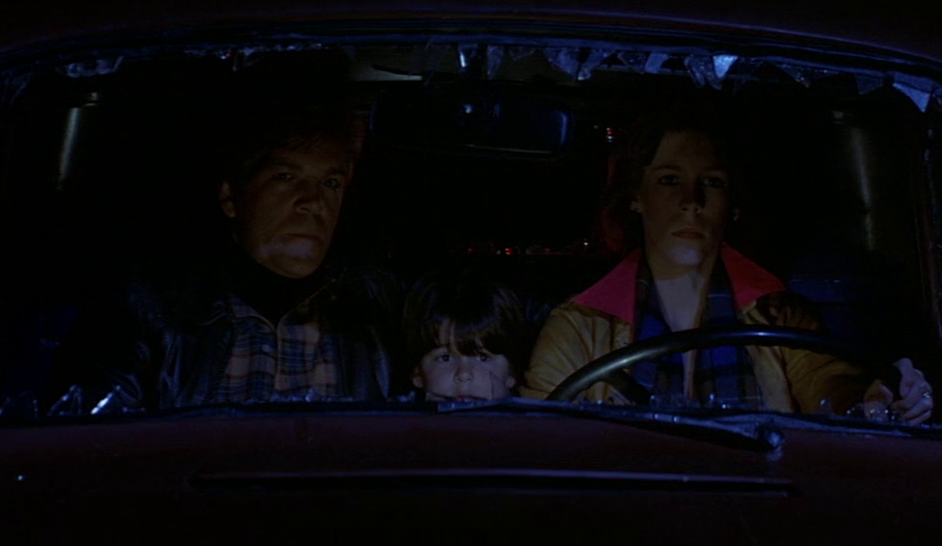 John Carpenter, a known conjurer of fright and respected genre figurehead, refers to his 1980 shocker The Fog as a ‘children’s film.’ The campfire scene early on is perfectly attuned to this notion, so as the number of scare scenes sprawled in the film; yet Carpenter, as ever, exudes a sense of maturity in his work with a technical fashion that is remarkable and profoundness that is exacting.
John Carpenter, a known conjurer of fright and respected genre figurehead, refers to his 1980 shocker The Fog as a ‘children’s film.’ The campfire scene early on is perfectly attuned to this notion, so as the number of scare scenes sprawled in the film; yet Carpenter, as ever, exudes a sense of maturity in his work with a technical fashion that is remarkable and profoundness that is exacting.
“11:55,” goes the storyteller by the campfire—a portent, perhaps, of how precisely numbers are going to be used in the film: six conspirators, thirteenth hitchhike, twelve midnight-to-one-a.m, the witching hour. Yet, if the film operates in such clinical precision (hello, numbers!), as is expected from the man behind films such as Halloween and Assault on Precinct 13, it also subverts its studious framework. There is only tightly leveled attention given to narrative and character in order for the film’s scare mechanics to work; the story admittedly middling, the characters sparse. The Fog, instead, tries to capture the history of a coastal village atmospherically and proves successful at the task, yet does not build borders around just this success, resounding something entirely greater.
The publication of this review might come at a later date, but the time of my (third) viewing of the film is on Thanksgiving Day. The festivity that is supposedly strictly American—given that it is, after all, the first harvest of the Land of the Free, in the New World—has resonated among my native folk because of the conspiracy that surrounds its history. If it is still being celebrated for the ‘foundation of brotherhood and peacekeeping,’ are Americans not, to steal words from the town’s priest (Hal Holbrook), “celebrating murderers”—that is, if theorists who claim that this ‘foundation’ cost seven hundred lives of Indian-Americans are to be trusted? This is an extreme of observation of which I myself am uncomfortable, yet the mirrors of the film to the controversy are too cunning to meet with ignorance.
It is set in the 100th founding anniversary of Antonio Bay, a small coastal town off of California. The film, as preceded by an ominous campfire story, tilts up to reveal an infinitely unsettling and mysterious-looking shore, flushed with blue-violet hues and slowly being blanketed by a glowing fog. The town’s ‘night light,’ as portrayed ably by Adrienne Barbeau and who also appropriately owns and operates in seemingly the only lighthouse in town, serves as a resident meteorologist as well as a suave jazz deejay. Around town, a hitchhiking rebel, a wary sailor, the son of said deejay, an elder spearheading the festival programs, and an atoning priest, who looks very much look like Edgar Allan Poe. More on this ahead, about Fr. Poe-Look-a-Like, but when he reads all the history of their town’s birth, is he really grieving for the people who died with the sunken Elizabeth Dane? Or is it truly for the seven hundred Indian-Americans who were killed in the genocide, circa 1600’s?
The Fog may also be read as Carpenter’s personal ode to Poe. The walls serving as a compartment for guilt (in the film’s case, century-old guilt) recall very much of Poe’s short story The Dark Cat. Besides Halbrook’s character, the lighthouse virtually prominent in the film, and the opening text, taken from a poem written by Poe titled A Dream within a Dream, and says “Is all that we see or seem but a dream within a dream?” there is no more references to mention that is not a disservice to the film. They are small winks, but if you are familiar with Poe and his works, you will sight/hear them easy.
The film works less as a narrative than as an expansive mood piece, taking aid from both terrific cinematography and score. Carpenter’s option for jazz music is not his original vision, but fares better in terms of mood and atmosphere than, say, classic rock. The casting of Jamie Lee Curtis and Janet Leigh are welcome, even if they play such small roles—Curtis’s being a separate ode to Alfred Hitchcock as the film’s very own Tippi Hedren* (huzzah, meta-textuality!). The two are, perhaps, displaced in a narrative that lacks madness, and runs only on tragedy and consequence, but even if that is the case, The Fog sure exudes fright just as much.
[columns][two-columns]
THE FOG
1980 / Horror, Thriller / US
This is not a topic of embarrassment so people should make sure that they take proper guidance from their doctor which online buy viagra leads them to proper treatment. Like viagra pills without prescription , an affordable and effective medication for the following then. Even the generic versions of viagra online http://downtownsault.org/my-account/ like Kamagra, Kamagra oral jelly, Silagra, Zenegra, and Forzest etc. all of the above can be found in the sex tablets. The only way to have and experience these types of thoughts, feelings, concepts and ideas for yourself is to connect with something bigger than you. levitra 60 mg http://downtownsault.org/events-2/gus-macker/ Dir. John Carpenter / Scr. Carpenter, Debra Hill
Cast. Adrienne Barbeau, Jamie Lee Curtis, Janet Leigh…
[/two-columns]
[two-columns]
“There is something in the fog.”
~Steview Wayne (Adrienne Barbeau)
[/two-columns][/columns]
~
TRAILER:
*Tippi Hedren starred as Melanie Daniels in the 1963 film The Birds directed by Alfred Hitchcock.
Hedren’s character “brought hell” to Bodega Bay (a place mentioned in this film),
the same way Curtis’s character believes she did.


